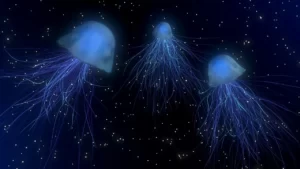Long-banned pollutants have made their way to the deepest part of the ocean
3 Mei 2023Photo: Pixabay/TheDigitalArtist
I was part of a team that recently discovered human-made pollutants in one of the deepest and most remote places on Earth – the Atacama Trench, which goes down to a depth of 8,000 meters in the Pacific Ocean. The presence of polychlorinated biphenyls (PCBs) in such a remote location emphasises a crucial fact: no place on Earth is free from pollution.
PCBs were produced in large quantities from the 1930s to the 1970s, mostly in the northern hemisphere, and were used in electrical equipment, paints, coolants and lots of other products. In the 1960s, it became clear they were harming marine life, leading to an almost global ban on their use in the mid-1970s.
However, because they take decades to break down, PCBs can travel long distances and spread to places far from where they were first used, and they continue to circulate through ocean currents, winds and rivers.
Our study took place in the Atacama Trench, which tracks the coast of South America for almost 6,000km. Its deepest point is roughly as deep as the Himalayas are high.
We collected sediment from five sites in the trench at different depths ranging from 2,500m to 8,085m. We sliced each sample into five layers, from surface sediment to deeper mud layers, and found PCBs in all of them.
Pollutants stick to dead plankton
In that part of the world, ocean currents bring cold and nutrient-rich waters to the surface, which means lots of plankton – the tiny organisms at the bottom of the food web in the oceans. When plankton die, their cells sink to the bottom, carrying with them pollutants such as PCBs. But PCBs don’t dissolve well in water and instead prefer to bind to tissues rich in fat and other bits of living or dead organisms, such as plankton.
Since seabed sediment contains a lot of remnants of dead plants and animals, it serves as an important sink for pollutants such as PCBs. About 60% of PCBs released during the 20th century are stored in deep ocean sediment.

A deep trench like the Atacama acts like a funnel that collects bits of dead plants and animals (what scientists refer to as “organic carbon”) that come falling down through the water. There is a lot of life in the trench, and microbes then degrade the organic carbon in the seafloor mud.
We found that the organic carbon at the deepest locations in the Atacama Trench was more degraded than at shallower places. At the greatest depths, there were also higher concentrations of PCB per gram of organic carbon in the sediment. The organic carbon in the mud is more easily degraded than the PCBs, which remain and can accumulate in the trench.
A look into the past
The storage of pollutants means ocean sediment can be used as a rear-view mirror on the past. It is possible to determine when a sediment layer accumulated on the seafloor, and by analysing pollutants in different layers we can gain information about their concentrations over time.
The sediment archive in the Atacama Trench surprised us. PCB concentrations were highest in the surface sediment, which contrasts to what we usually find in lakes and seas. Typically, the highest concentrations are found in lower layers of sediment that were deposited in the 1970s through to the 1990s, followed by a decrease in concentrations towards the surface, reflecting the ban and reduced emissions of PCBs.
For now, we still don’t understand why the Atacama would be different. It is possible that we didn’t look at the sediment closely enough to detect small variations in PCBs, or that concentrations have not yet peaked in this deep trench.
These concentrations are still quite low, hundreds of times lower than in areas close to human pollution sources such as the Baltic Sea. But the fact we have found any pollution whatsoever shows the magnitude of humanity’s influence on the environment.
What we can say for sure is that the more than 350,000 chemicals currently in use globally come at a cost of polluting the environment and ourselves. Pollutants have now been found buried below the bottom of one of the world’s deepest ocean trenches – and they’re not going anywhere.
This article was written by a professor of Environmental Chemistry and head of the Department of Environmental Sciences at Stockholm University. It is republished from The Conversation under a Creative Commons license. Read the original article.
The post Long-banned pollutants have made their way to the deepest part of the ocean appeared first on Sustainability Times.
